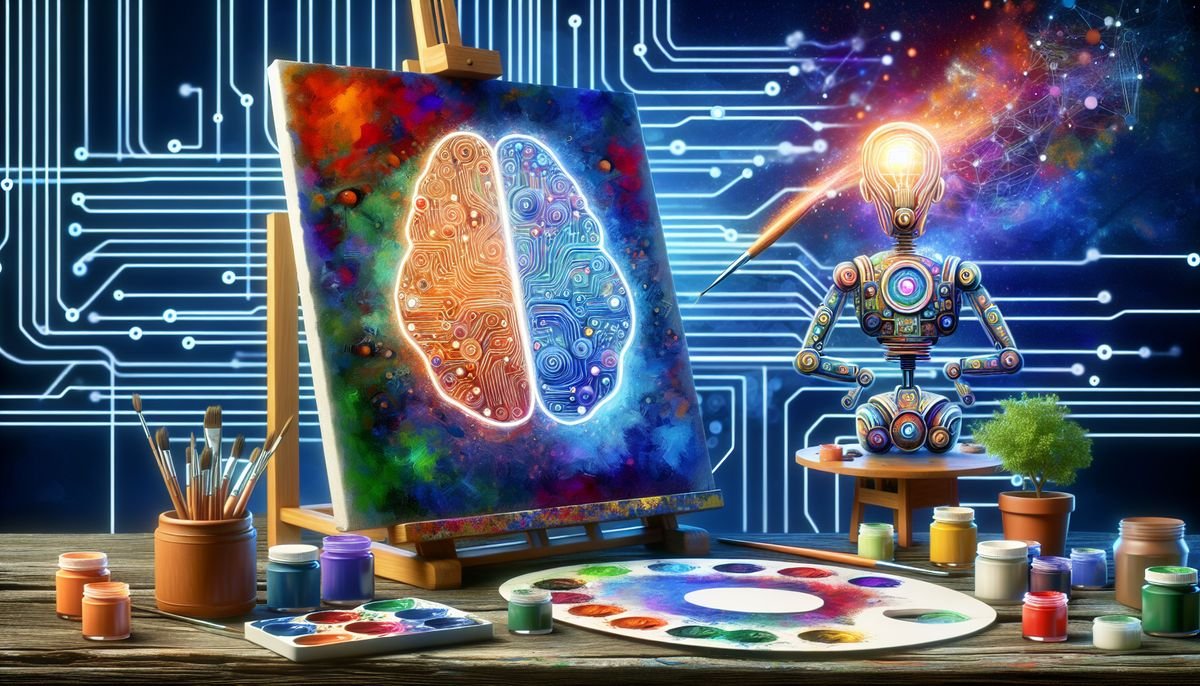In today’s rapidly evolving digital landscape, the intersection of artificial intelligence and creative expression has given rise to groundbreaking tools that are reshaping the way businesses approach visual content. One such innovation that has garnered significant attention is DALL-E 2, an AI-generated art platform that pushes the boundaries of creativity and imagination. This article explores the capabilities of DALL-E 2 and how it can revolutionize the visual aspects of your business.
Key Takeaways
- DALL-E 2 offers advanced capabilities in understanding context and relationships between objects, leading to highly accurate visual outputs.
- Integration capabilities of DALL-E 2 enable seamless generation of images within collaborative tools like Slack, enhancing productivity and creativity in communication.
- Utilizing AI art generators like DALL-E 2 streamlines the creative process from conception to realization, offering a spectrum of choices for artists and businesses.
What is DALL-E, and How Does it Contribute to AI-Driven Digital Art?
DALL-E by OpenAI
OpenAI’s DALL-E has evolved into its third iteration, known as DALL-E 3, which has significantly advanced the capabilities of AI in generating digital art. This model is not only faster but also more adept at creating images that closely align with the given textual prompts. The recent updates have been particularly focused on enhancing the authenticity and originality of the generated images, making it a powerful tool for businesses looking to innovate their visual content.
One of the trending topics in the past few months is the introduction of new watermarks to DALL-E 3. OpenAI has announced that it will incorporate watermarks from the Coalition for Content Provenance and Authenticity (C2PA) in all images generated by DALL-E 3. This move is aimed at tagging AI-generated content to ensure its origin can be verified, which is crucial as the use of AI in content creation becomes more widespread.
The integration of C2PA watermarks is a significant step towards establishing a standard for digital content authenticity, providing a layer of security and trust for businesses and consumers alike.
DALL-E 3’s ability to produce highly realistic images in a matter of minutes opens up a plethora of opportunities for various industries. From creating illustrations and designing products to generating innovative ideas, the potential applications are vast. Below is a list of some of the key benefits that DALL-E 3 offers to businesses:
- Rapid generation of high-quality images
- Customizable outputs based on detailed prompts
- Expansion of creative possibilities without the need for traditional artistic skills
- Streamlining the design process for products and marketing materials
Unique Image Generation
The advent of AI-generated art has opened up a new realm of possibilities for businesses looking to stand out with original visual content. DALL-E 2, a prominent image generator by OpenAI, has been at the forefront of this revolution, enabling the creation of images that are not just unique, but also tailored to specific needs and styles.
One of the most exciting applications of DALL-E 2 in recent months has been in the generation of custom pet portraits. Services like Petpic and Dreamy Paws have leveraged AI to transform ordinary pet photos into creative masterpieces, each with a distinctive flair that captures the personality of the pet in ways traditional photography cannot.
The beauty of AI-generated art lies in its ability to produce visuals that are entirely new, ensuring that every piece is a unique creation until shared.
For businesses, this means the opportunity to generate bespoke imagery that can enhance brand identity and engage customers. From photorealistic product photos to whimsical character designs, the scope of AI-generated visuals is vast. Below is a list of some recent trending applications:
- Custom AI art and illustrations
- AI-designed app icons
- Photorealistic 3D textures
- AI-generated coloring pages
- Personalized AI-powered designs
The potential of AI in the realm of digital art is not just about creating something new; it’s about crafting an experience that resonates with the audience, whether it’s through a playful Fakemon or a sophisticated brand mockup.
Expanding Creative Possibilities
The advent of DALL-E 2 has not only enhanced the creative efficiency of artists but also provided personalized artistic assistance. By quickly generating prototypes, layouts, and concept art, AI is reshaping the workflow of visual creators, allowing them to iterate and refine their ideas at an unprecedented pace.
With DALL-E 2, the boundaries of creativity are being pushed further, as it offers innovative capabilities that were once thought to be exclusive to human ingenuity. This AI tool is not just a facilitator but a collaborator in the artistic journey.
The integration of AI into digital art has led to the development of adaptive learning tools and generative techniques that can produce a wide array of visual content. For instance:
- Generative Techniques:
- Deep Dream Generator: Adds visual complexity akin to the human subconscious.
- GANs (Generative Adversarial Networks): Drive hyperrealistic or entirely novel aesthetics.
- Integration and Application:
- Seamless integration with communication platforms like Slack and Airtable.
- Expansion into other creative fields beyond static images, such as interactive media and virtual reality.
These advancements suggest a future where AI and human creativity coexist in a symbiotic relationship, with AI serving as both a tool and a partner in the realm of art-making.
Other Digital Art Software Tools Incorporating AI for Various Creative Purposes
Utilizing AI Art Generators
In recent months, the use of AI art generators has surged, with platforms like DALL-E 2 and Prodia leading the charge in transforming the digital art landscape. These generators have become essential tools for artists and designers, offering a spectrum of choices that streamline the journey from conception to realization.
The best AI art tutorials now include comprehensive guides on how to maximize the potential of AI image generators such as Firefly, Midjouney V6, DALL-E 3, and Stable Diffusion. These tutorials cover everything from crafting effective prompts to fine-tuning parameters, ensuring that users can harness the full power of these platforms.
By harnessing AI art generators’ capabilities, artists and designers can expedite the creative process, turning text-based prompts into detailed visual artworks with remarkable efficiency.
AI art generators offer several advantages to graphic designers and artists, including time and cost savings. Tasks such as cropping, resizing, filtering, and enhancing images can be accomplished with unprecedented speed and precision, allowing for greater focus on the creative aspects of design.
Integration Capabilities
The integration of AI into digital art software tools has been a game-changer for artists and designers. Platforms like RunwayML have simplified the process of incorporating machine learning models into creative projects, offering intuitive interfaces and plugins that cater to the needs of the modern digital artist. This seamless integration is pivotal in revolutionizing how artists interact with technology, allowing them to focus more on the creative aspects of their work.
One of the most significant trends in the past few months has been the democratization of AI art generation. Tools like iPic.Ai have been integrated into user-friendly platforms such as Canva, enabling a broader range of users to access text-to-image functionalities. This trend is not just about accessibility; it’s about providing the means for all levels of creators to produce high-quality visuals with minimal effort.
The impact of these integrations on workflow efficiency cannot be overstated. Designers can now leverage AI to interpret complex design requests and execute them with precision, thanks to the learning capabilities of these tools from vast datasets. The table below illustrates the impact of key features on AI-generated art:
| Feature | Impact on AI Art | Technical Aspect |
|---|---|---|
| Generative Capability | Diverse visual content | High-dimensional data modeling |
| Learning Efficiency | Enhanced quality and variety | Complex data distribution learning |
| Neural Style Transfer | Unique artistic expressions | Encoding and decoding complex inputs |
The evolution of AI-driven design is not just about the technology; it’s about empowering creators to explore new realms of digital aesthetics while maintaining an efficient and intuitive workflow.
Comparison of AI Image Generators
In the rapidly evolving landscape of AI-generated art, a multitude of tools have emerged, each with unique features and capabilities. The best AI image generators of 2024 offer a diverse range of functions, from generating simple graphics to producing complex, high-resolution images that can rival those created by humans. These tools are not only transforming the creation of visual content but are also expanding the horizons of AI’s creative potential.
Here’s a brief comparison of some of the leading AI image generators:
- DALL-E 2: Known for its Slack integration, allowing for seamless image generation from text within a team’s communication platform.
- Prodia: Utilizes advanced diffusion models to deliver high-quality AI images.
- StarryAI: Specializes in abstract and ethereal styles through its text-to-image AI technology.
- Bing Image Creator: Microsoft’s contender in the AI art space, featuring the AI Time Machine function.
- Leap AI: Offers a user-friendly interface and a free trial, making it accessible for beginners.
AI image generators use text prompts to produce images within seconds, democratizing creative expression and enabling a wide audience to engage in artistry.
As we continue to explore the capabilities of these generators, it’s clear that they are not only tools for artists but also for businesses looking to revolutionize their visual media. The integration of AI into digital art software is a testament to the ongoing innovation in the field, providing users with unprecedented creative freedom.
Conclusion
In conclusion, the exploration of DALL-E 2 and other AI-generated art tools has revealed a new era of creativity and innovation in the digital art landscape. These tools, such as DALL-E 3, Adobe Firefly, and DALL-E Mini, are revolutionizing the way businesses can visualize their ideas and concepts. By leveraging the power of AI art generators, businesses can streamline their creative processes and bring unique visuals to life with ease. The integration capabilities of DALL-E 2, allowing image generation within collaborative tools like Slack, showcase the potential for increased productivity and creativity in communication. As AI-driven digital art continues to evolve, it promises to reshape the way we approach visual content creation and opens up endless possibilities for artistic expression.
Frequently Asked Questions
How does DALL-E contribute to AI-driven digital art?
DALL-E, developed by OpenAI, is a GAN-based model that generates unique images based on textual prompts. It allows artists to input descriptive text and receive AI-generated visuals, expanding creative possibilities.
What are the integration capabilities of DALL-E 2?
DALL-E 2 stands out with its integration capabilities, allowing users to generate images directly within collaborative tools like Slack. This seamless incorporation enhances productivity and inspires creativity in communication.
How do AI art generators like DALL-E 2 streamline the creative process?
Utilizing AI art generators like DALL-E 2 and Prodia, creatives have a spectrum of choices that streamline the journey from conception to realization.



